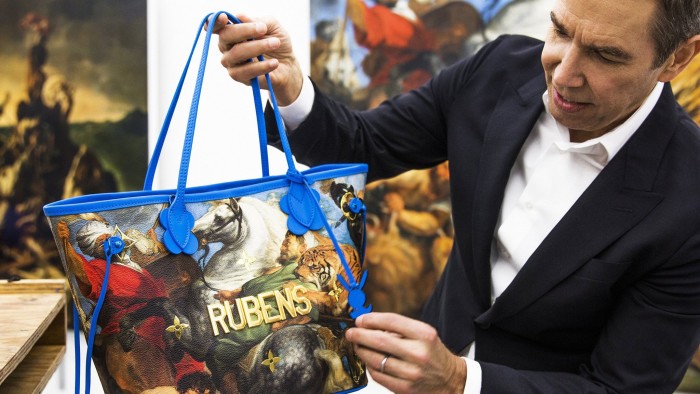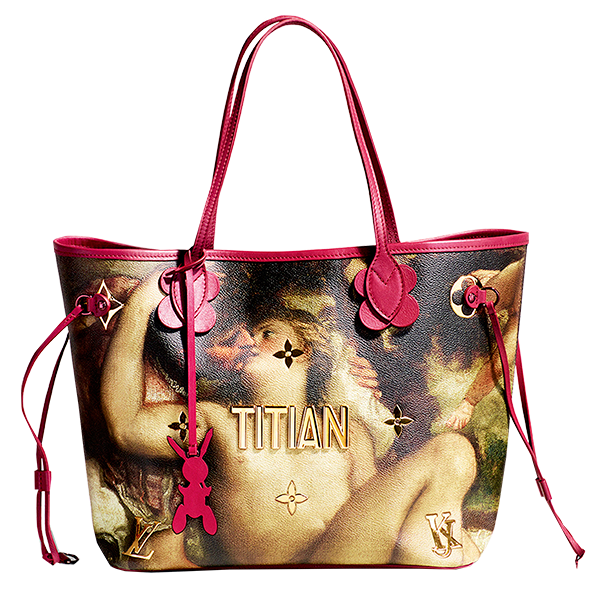Master pieces? Jeff Koons on his first collaboration with Louis Vuitton

Simply sign up to the Life & Arts myFT Digest -- delivered directly to your inbox.
It’s quite the fabulous marriage: Jeff Koons, the American artist and flower-puppy creator who claims the highest figure ever paid for a work by a living artist, has teamed up with Louis Vuitton, one of the world’s biggest and most commercially buoyant brands, to create a range of bags printed with some of the world’s best-known artworks.
Koons is the fourth artist the brand has invited to work with the distinctive monogrammed canvas, first conceived in 1896 by George Vuitton to honour his late father. Stephen Sprouse, Takashi Murakami and Yayoi Kusama have all scrawled, animated and polka-dotted its surfaces in the years since, but no one has been allowed the same licence to play with the patented design as Koons has in this latest update. In addition to emblazoning the bags with five major works, which include Fragonard’s “Young Girl Playing with her Dog”, Rubens’ “Tiger Hunt” and Leonardo da Vinci’s “Mona Lisa”, the bags also include a new arrangement of Koons’ own entwined initials, a rearrangement of the house foils and a dangling leather bunny charm.
“I worked with LVMH when I worked on a project for Dom Pérignon [in 2003], and it was a fantastic experience,” says Koons from his New York apartment of the opportunity. “It was such a pleasure to work with their facilities. So I enjoyed working with them on the sense of materialism, the quality of materials, and pushing things to their limitations.”
The collection is colourful, bold and highly accessible — even if the price tags pitch the products far beyond the pockets of most ordinary people (£2,240 for a Rubens backpack; or a “Speedy” decorated with a Van Gogh wheat field, £1,960). But it won’t be without its detractors. Koons, who has long tiptoed the critical divide with his particular blend of art appropriation and popular idealism, not to mention his habit for turning ordinary tourist tat and kitschy merchandise into monumental artworks, has approached this collaboration with customary chutzpah. Few artists would dare invoke the name of an Old Master in their own work — much less stamp his own initials alongside them.

For Koons, though, the works are all part of a more general “celebration” in which he sees his role as shining a light on the history of art. “I see them as part of the world and I cannot wait to see them coming down the street or see them in the restaurant, because I think they are moments of humanism,” he continues in his long, loquacious drawl. “And, really, how wonderful is it to find things outside the self that you can find greater interest in? All these artists have done that. Rubens is Rubens because he loved Leonardo da Vinci and Titian. And Monet, he loved Goya, and he loved Raphael . . .
“Artists are able to transcend and reach a higher level, but we do this every day in our own lives,” he continues. “And I hope the bags are a symbol of humanism, and about the joy of society and communal life, and about participating in that community. I wanted the monogram to feel fresh, so I thought that putting in a JK with the LV was a freshening device.” Even the typography in which the artists’ names are written “has a little bit of street bling to it”.

Blinging da Vinci aside, for Louis Vuitton, the collaboration is also a way of re-engaging people with the dustier art works of the world’s great gallery spaces. Louis Vuitton chief executive Michael Burke, who worked on the collaboration alongside Delphine Arnault, executive vice-president of Louis Vuitton, says that the bags will “revive the masterpiece”. And for customers who like their luxury to come with added self-improvement tools, they have an educative side as well: each bag’s interior is printed with a brief biography and sketch of the artist.
Koons is more cavalier about the bags’ didactic reach. “I don’t think anyone needs to know anything about art history,” he says of their purpose. “The art never requires anything of you. They are very iconic works — but you don’t need to know anything, it’s just about the reaction to something. It’s about you, it’s about the viewer, how you feel.”

Certainly, the collaboration should bag Louis Vuitton a lot of money. Just as Marc Jacobs’ Sprouse collection, featuring scarves and accessories daubed with the artist’s signature script, helped transform the fortunes of the house in 2001, so is it expected that Koons’ contribution will ignite sales. If successful, the artist plans to add to the collection with future collaborations that will draw from the 40 paintings he used for his initial “Gazing Ball” series of 2014-15.
But should these handbags be mounted on the wall, or used as receptacles for old bus tickets, mascara wands and dog-eared paperbacks? “For me, what’s wonderful about art is the emotional experience,” he replies of their status. “I’m curious about an intellectual and physical response to something, and if someone wants to have ownership of that? Fantastic.”

Koons’ confidence is breathtakingly gauche. I’m reminded of an article in Vice magazine that once described him as the art world’s equivalent of the elliptical musician Kanye West. His insights can be maddeningly gnomic. But however opaque his conversation, his bags do have a genuinely pleasing quality in the flesh: the Fragonard, with its pink-cheeked infant fondling a dog, takes on a new provocative nuance when placed on a rucksack; the vivid bright brushstrokes of the Rubens are electric. Even the enigmatic “Mona Lisa” looks a little more liberated away from her bulletproof shield at the Louvre. They’re jolly and, like so many of Koons’ works, quite irresistibly charming, even though they might occasionally recall the printed tote bags you might pick up at in a museum shop.
How would Koons define this brand of luxury? “I guess that luxury would be what you get if you throw everything at something,” he answers. “I believe we have created something that celebrates materials and taking things to a limit, really raising the bar to a watermark in terms of what you can do with printing in canvas and leather? It’s experimenting and it’s trying to enjoy materials.”

He takes a breath, and then contradicts everything he’s just said. “Luxury is an abstraction, in a way,” he finishes. “I don’t know if I understand it completely. Yes, the economic means are there to be able to explore. But it’s not referencing. It’s not about ‘look at all the resources we have’. It’s not referencing the idea of luxury, it’s not about value. It’s about ideas and how to be of value to people.” It’s about a really swag bag to put your gym kit in as well.
Comments